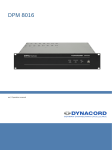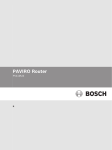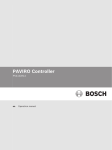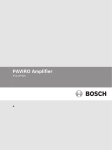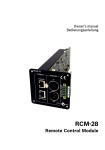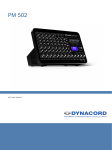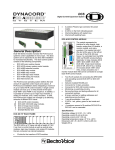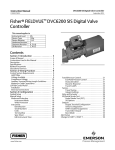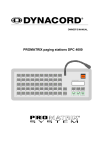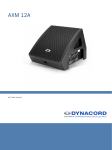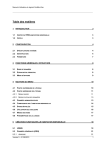Download PROMATRIX 8000 POWER AMPLIFIER
Transcript
PROMATRIX 8000 POWER AMPLIFIER en | User manual PROMATRIX 8000 POWER AMPLIFIER Table of contents | en 3 Table of contents 1 Safety information 4 2 Brief description 6 3 System overview 6 4 Scope of delivery and warranty 6 5 Installation 7 5.1 Front 7 5.2 Back 10 5.3 Installation 12 5.4 Cooling 12 6 Connections 13 6.1 Audio inputs 13 6.2 Power outputs on the output stage 15 6.3 CONTROL PORT 18 6.4 REMOTE CAN BUS 20 6.5 Supply voltage 22 6.6 End of line (EOL) 23 7 Configuration 25 7.1 Configuration of the output voltage 25 7.2 Setting the CAN address 28 7.3 Configuring the CAN baud rate 29 7.4 Pilot tone generator 30 7.5 Impedance measurement 30 8 Operation 31 9 Trouble shooting 33 10 Maintenance 33 11 Technical data 33 11.1 DPA 8150 33 11.2 DPA 8225 37 11.3 DPA 8412 40 11.4 Block diagram 42 11.5 Dimensions 43 User manual 19-Aug-13 | 03 | F01U217494 4 en | Safety information 1 PROMATRIX 8000 POWER AMPLIFIER Safety information Danger! The lightning symbol inside a triangle notifies the user of high-voltage, uninsulated lines and contacts inside the devices that could result in fatal electrocution if touched. Warning! ! An exclamation mark inside a triangle refers the user to important operating and service instructions in the documentation for the equipment. 1. Read these safety notes. 2. Keep these safety notes in a safe place. 3. Heed all warnings. 4. Observe all instructions. 5. Do not operate the device in close proximity to water. 6. Use only a dry cloth to clean the unit. 7. Do not cover any ventilation slots. Always refer to the manufacturer's instructions when installing the device. 8. Do not install the device close to heaters, ovens, or other heat sources. 9. Note: The device must only be operated via the mains power supply with a safety ground connector. Do not disable the safety ground connection function of the supplied power cable. If the plug of the supplied cable does not fit your mains socket, please contact your electrician. 10. Ensure that it is not possible to stand on the mains cable. Take precautions to ensure the mains cable cannot become crushed, particularly near the device connector and mains plug. 11. Only use accessories/extensions for the device that have been approved by the manufacturer. 12. Unplug the device if there is risk of lightning strike or in the event of long periods of inactivity. However, this does not apply if the device is to be used as part of an evacuation system! 13. Have all service work and repairs performed by a trained customer service technician. Service work must be carried out immediately following any damage such as damage to the mains cable or plug, if fluid or any object enters the device, if the device has been used in rain or become wet, or if the device has been dropped or no longer works correctly. 19-Aug-13 | 03 | F01U217494 User manual PROMATRIX 8000 POWER AMPLIFIER Safety information | en 5 14. Please ensure that no dripping water or spray can penetrate the inside of the device. Do not place any objects filled with fluids, such as vases or drinking vessels, on top of the device. 15. To ensure the device is completely free of voltage, unplug the device from the power supply. 16. When installing the device, ensure that the plug is freely accessible. 17. Do not place any sources of open flame, such as lit candles, on top of the device. 18. This PROTECTION CLASS I device must be connected to a MAINS socket with a safety ground connection. Caution! Use only manufacturer-approved carts, stands, brackets, or tables that you acquired together with the device. When using carts to move the device, make sure the transported equipment and the cart itself cannot tip over or cause injury or material damage. IMPORTANT SERVICE INFORMATION Caution! This service information is for use by qualified service personnel only. To avoid the risk of ! electric shock, do not perform any maintenance work that is not described in the operating instructions unless you are qualified to do so. Have all service work and repairs performed by a trained customer service technician. 1. Repair work on the device must comply with the safety standards specified in EN 60065 (VDE 0860). 2. A mains isolating transformer must be used during any work for which the opened device is connected to and operated with mains voltage. 3. The device must be free of any voltage before performing any alterations with upgrade 4. The minimum distance between voltage-carrying parts and metal parts that can be sets, switching the mains voltage, or performing any other modifications. touched (such as the metal housing) or between mains poles is 3 mm, and must be observed at all times. 5. The minimum distance between voltage-carrying parts and circuit parts that are not connected to the mains (secondary) is 6 mm, and must be observed at all times. 6. Special components that are marked with the safety symbol in the circuit diagram (note) must only be replaced with original parts. 7. Unauthorized changes to the circuitry are prohibited. 8. The protective measures issued by the relevant trade organizations and applicable at the place of repair must be observed. This includes the properties and configuration of the workplace. 9. Observe the guidelines with respect to handling MOS components. Danger! SAFETY COMPONENT (MUST BE REPLACED BY ORIGINAL PART) User manual 19-Aug-13 | 03 | F01U217494 6 2 en | Safety information PROMATRIX 8000 POWER AMPLIFIER Brief description The DPA POWER AMPLIFIERS in the DPA 8000 series are class-D amplifiers and can be operated from both the mains and a DC supply. The output voltage is galvanically isolated and is constantly monitored for ground fault. An energy-saving mode and temperature-controlled fan reduce energy consumption and noise levels. The control and monitoring functions are performed via REMOTE CAN BUS. The DPA POWER AMPLIFIERS are designed for operation in an emergency sound system. The amplifiers are usually controlled via the DPM 8016 PROMATRIX CONTROLLER and configured using IRIS-Net. To use a DPA without the DPM 8016, a configuration can be created using IRIS-Net and stored permanently in the DPA. The desired configuration (preset) is then applied each time the DPA is restarted. 3 System overview The PROMATRIX 8000 system includes the following power amplifiers: • DPA 8150 with 1 x 500 W • DPA 8225 with 2 x 250 W • DPA 8412 with 4 x 125 W All power amplifiers have the following features: • Ungrounded 100-volt power outputs (internally reconfigurable to 70 V or 50 V) • Amplifier blocks in class-D technology • Outputs idling and short circuit-protected • Mains operation 230 V/120 V AC and/or 24-V DC emergency backup • Electronically balanced inputs • Temperature monitoring function • Pilot tone and ground fault monitoring function • Malfunction message via potential-free READY contact • Processor control of all functions • Monitoring of the processor system via watchdog circuit • Non-volatile FLASH memory for configuration data • Internal monitoring function • Integrated audio relays • Line monitoring function The power amplifiers are processor-controlled and equipped with extensive monitoring functions. A watchdog circuit is built in to monitor the processor system. Line monitoring for the CAN bus and for audio transmission allows line interruptions and short-circuits to be detected and indicated to the user. The power amplifiers for the PROMATRIX 8000 system can be configured quickly and easily using the IRIS-Net software. The properties can be configured using a graphical dialog-based user interface. 4 Scope of delivery and warranty Number DPA 8150 Component DPA 8225 DPA 8412 1 Output stage 1 Operating manual 1 Mains cable 1 2-pin connector (24-V DC input, F01U108398) 19-Aug-13 | 03 | F01U217494 User manual PROMATRIX 8000 POWER AMPLIFIER Safety information | en Number 7 Component DPA 8150 DPA 8225 DPA 8412 4 6 10 3-pin connector (audio input, F01U104680) 3 2 4 6-pin connector (audio output, F01U104179) 1 8-pin connector (GPIO, F01U108447) 1 Warranty card with safety information Table 4.1: Scope of delivery Warranty For information regarding the warranty, see www.dynacord.com 5 Installation 5.1 Front 1 User manual 2 3 5 6 7 8 4 19-Aug-13 | 03 | F01U217494 8 en | Safety information PROMATRIX 8000 POWER AMPLIFIER Number Element Description 1 SIGNAL LED and There is a SIGNAL LED and a LIMIT LED for each channel of the LIMIT LED output stage: • The SIGNAL LED for a channel lights up green at approx. 30 dB below the manual override limit. • The LIMIT LED will light up red if the dynamic audio limiter of the output has been activated. This can occur if the input signal is too high or if the output load is too great. In this case, lower the input signal. In the event of a shortcircuit to the output lines, the output voltage will be reduced until the output current falls below the limit value. The output voltage can remain at this reduced level until the temperature level causes the output stage to be switched off. 2 PROTECT LED The PROTECT LED lights up red when an internal protective circuit in the amplifier has been activated, for example in the event of • Excessive temperature • Power supply under voltage • Battery under voltage • Short-circuit at the amplifier output If PROTECT is active, the amplifier channel concerned or all amplifier channels are switched off. 3 REMOTE LED The REMOTE LED lights up green in the event of successful data communication with the DPM 8016. 4 STANDBY LED The STANDBY LED lights up yellow when the amplifier is in standby mode. Further information can be found in the section entitled Supply voltage, page 22 5 GROUND LED The GROUND LED lights up red when a ground fault has occurred at at least one output. The LED remains illuminated even when the ground fault has been rectified. To deactivate the LED, press the FAULT button (7) or use IRIS-Net. Further information can be found in the section entitled Operation, page 31 6 FAULT LED The FAULT LED lights up yellow when a fault has occurred in the amplifier. The types of faults to be displayed via these LEDs are configured in IRIS-Net. Further information can be found in the section entitled Operation, page 31 19-Aug-13 | 03 | F01U217494 User manual PROMATRIX 8000 POWER AMPLIFIER Safety information | en Number Element Description 7 The FAULT button has the following functions: FAULT button • 9 Resetting a ground fault: Press the FAULT button briefly to confirm a ground fault. If the ground fault has been rectified at the output, the GROUND LED switches off • Simulation of a fault: While the FAULT button is pressed, a fault is simulated in the DPA. This makes it possible to manually switch to corrective mode • Setting/displaying the CAN baud rate – see the section entitled Configuring the CAN baud rate, page 29. • Resetting to delivery condition: To reset all settings to their original configuration on delivery, set the CAN address to 00. Then press the FAULT button for at least three seconds to reset all amplifier settings The FAULT button is protected to prevent it from being pressed accidentally. Use a pointed object (such as a ballpoint pen) to press the button. 8 POWER LED The POWER LED lights up green when the power supply is OK. User manual 19-Aug-13 | 03 | F01U217494 10 5.2 en | Safety information PROMATRIX 8000 POWER AMPLIFIER Back 1 13 3 2 12 11 10 4 5 6 7 9 8 Figure 5.1: DPA 8150 1 13 12 3 2 11 10 4 5 6 7 9 8 Figure 5.2: DPA 8225 1 13 12 3 2 11 10 4 5 6 9 Figure 5.3: DPA 8412 19-Aug-13 | 03 | F01U217494 User manual 7 8 PROMATRIX 8000 POWER AMPLIFIER Safety information | en 11 Number Element Description 1 Power output terminals OUT Power output for speaker zones; for further information see the section entitled Power outputs on the output stage, page 15 2 AEC audio input, AEC Common audio input for all channels. For further information see the section entitled Audio inputs, page 13 3 CONTROL PORT with READY Control port with inputs, open collector contact outputs and potential-free READY relay contacts. For further information see the section entitled CONTROL PORT, page 18 4 CAN ADDRESS selector switch HIGH-byte and LOW-byte for configuring the CAN address. For further information see the section entitled Setting the CAN address, page 28 5 STATUS LED The yellow STATUS LED indicates the current status of the CAN connection. Further information can be found in the section entitled Setting the CAN address, page 28 6 REMOTE CAN BUS connections Connection with CAN bus, e.g. DPM 8016. For further information see the section entitled REMOTE CAN BUS, page 20 7 Extension slot Enables an extension module to be retrofitted. 8 Direct audio input Direct audio input (IN) per channel; for more information see the section entitled Audio inputs, page 13 9 Type plate 10 DC INPUT 24 V DC input; for further information see the section entitled Supply voltage, page 22 11 VOLTAGE SELECTOR Selection of the power supply voltage; for further information see the section entitled Supply voltage, page 22 12 AC MAINS INPUT AC input; for further information see the section entitled Supply voltage, page 22 13 POWER switch Power switch; for further information see the section entitled Supply voltage, page 22 User manual 19-Aug-13 | 03 | F01U217494 12 5.3 en | Safety information PROMATRIX 8000 POWER AMPLIFIER Installation The DPA output stage has been designed to be installed horizontally in a conventional 19” rack cabinet. In general, an installation location must be selected in which the output stage is protected from the following conditions: • Dripping water or spray • Direct sunlight • High ambient temperatures or direct effect of sources of heat • High level of humidity • Heavy dust accumulation • Strong vibrations Attaching the output stage to the front Attach the output stage to the front using four screws and washers as shown in the following diagram. Figure 5.4: Attaching the DPA output stage Notice! Use of installation rails When installing in rack cabinets, installation rails must always be used to prevent the front panel becoming distorted. 5.4 Cooling In the case of all fan-cooled DYNACORD output stages, the air flows from the front to the rear as cool fresh air tends to be available outside the rack rather than inside. This way, the output stage remains cooler and the resulting heat loss can be dissipated more efficiently. Figure 5.5: Air supply and ventilation As a rule, the output stage must be set up or mounted in such a way that the air supply at the front and the ventilation at the rear of the device are not impeded. When installing in housings and racks, it is important to ensure that the output stage is adequately ventilated. There must be a free channel of air of at least 60 mm x 330 mm between the back of the output stage and the interior of the cabinet/rack as far as the upper rack or cabinet ventilation system. There must be free space of at least 100 mm above the cabinet for ventilation. Because the temperature in the housing or cabinet can rise to as high as 40 °C when the output stage is in 19-Aug-13 | 03 | F01U217494 User manual PROMATRIX 8000 POWER AMPLIFIER Safety information | en 13 operation, the maximum permissible ambient temperature of the other devices in the rack cabinet must be observed. DPA-series output stages can be mounted in racks directly on top of one another without any clearance between them. However, since the amplifier housings heat up during operation, it may be advisable to maintain a distance of 1 height unit (1 HU) from other devices without forced cooling (e.g. controller). Caution! The ventilation openings on the output stage must not be blocked/closed. In the absence of ! cooling, the output stage can shut down automatically. Keep all ventilation openings free of dust/deposits that would impede the flow of air. Do not operate the output stage near heat sources such as fan heaters, ovens or other heat-generating devices. To ensure problem-free operation, the maximum ambient temperature of +45 °C must not be exceeded. For installations with a central cooling system or air-conditioning units, which are often used in permanent installations in special equipment rooms, it may be necessary to calculate the maximum heat emission level. See also the following section for more information on this topic. Heat buildup The requirements for the power supply and lines can be determined using the tables in the section entitled Technical data, page 33 . The power received from the mains is converted into output power for the speakers and into heat. The difference between the power received and the output power is called power dissipation (Pd). Heat generated from this dissipated power may remain in the rack. Appropriate measures must be taken to discharge the heat. The tables can also be used to calculate the heat ratios in the rack/cabinet or to work out the dimensions involved in any waste air measures required. The Pd column shows the power dissipation values for various operating statuses. Standby mode In standby mode, the energy consumption of the output stage is substantially reduced. It does not matter whether the output stage is supplied with power via the mains input or the DC input. In standby mode, the following functions are still available: • Remote control via the CAN bus • Monitoring of the mains input • Monitoring of the DC input • Function of the control port Standby mode is activated via the REMOTE CAN BUS, and is indicated by the STANDBY LED. 6 Connections 6.1 Audio inputs The following section describes the various audio inputs on the output stage. Direct input User manual 19-Aug-13 | 03 | F01U217494 14 en | Safety information PROMATRIX 8000 POWER AMPLIFIER For each channel of the output stage there is a direct line input with additional plug contacts switched in parallel which can be used to loop through the audio signal. With the help of integrated pilot tone monitoring, a missing or faulty input signal can be detected reliably. The audio inputs are electronically balanced. You must always use a balanced audio signal at the input of the output stage where this is possible. The scope of delivery for the device includes a 3-pin connector. Conductor cross-sections of 0.14 mm² (AWG26) to 1.5 mm² (AWG16) can be used. Recommended connecting cable: balanced cable with flexible 2 x 0.14 mm² shielding. AEC input The audio signal at the AEC input (audio emergency channel) can be switched internally to each amplifier channel. The volume level of the AEC signal can be adjusted separately. The plug contact switched in parallel can be used to loop through the audio signal. With the help of integrated pilot tone monitoring, a missing or faulty input signal can be detected reliably. The audio input is electronically balanced. You must always use a balanced audio signal at the input of the output stage where this is possible. The scope of delivery for the device includes a 3-pin connector. Conductor cross-sections of 0.14 mm² (AWG26) to 1.5 mm² (AWG16) can be used. Recommended connecting cable: balanced cable with flexible 2 x 0.14 mm² shielding. Notice! The separate level setting for the direct input or the AEC input is made during configuration in IRIS-Net. Balanced cabling The following diagram shows the balanced cabling of an audio input on the DPA output stage. Figure 6.1: Audio input balanced cabling Unbalanced cabling If the connecting cable(s) is/are very short and no interference signals are to be expected in the environment of the output stage, then an unbalanced signal can also be connected. In this case, it is imperative that a bridge in the input connector between the screen and the inverting input is switched (see diagram below), otherwise the level can drop by 6 dB. However, for reasons of immunity to external interference sources such as dimmers, mains supplies, HF control lines etc., balanced cabling is always preferable. 19-Aug-13 | 03 | F01U217494 User manual PROMATRIX 8000 POWER AMPLIFIER Safety information | en 15 Figure 6.2: Audio input unbalanced cabling 6.2 Power outputs on the output stage The audio outputs on the DPA output stage are galvanically isolated and are constantly monitored for ground fault. The scope of delivery for the device includes a 6-pin connector. Conductor cross-sections of 0.14 mm² (AWG26) to 1.5 mm² (AWG16) can be used. Recommended connecting cable: flexible CU strand, LiY, 0.75 mm². For ease of installation, the connector can be removed. With regard to the maximum number of speakers that can be connected, speakers can be connected until the point at which the total power consumption of the speaker network corresponds to the nominal power value of the output stage, where the rated load resistance of the output stage outputs is not to be exceeded. The nominal power values and the rated load resistances of the outputs can be found in the section entitled Technical data, page 33. Please also refer to the section entitled “Integrated relays” below. Notice! Outputs on the DPA 8150 Outputs F, G, and H on the DPA 8150 are arranged in ascending order from left to right. User manual 19-Aug-13 | 03 | F01U217494 16 en | Safety information PROMATRIX 8000 POWER AMPLIFIER 8 x 30 W 41 x 6 W Figure 6.3: Example of a DPA 8225 with a load of 8 x 30 W = 240 W or 41 x 6 W = 246 W at the outputs on the output stage Danger! The outputs can accept hazardous contact voltages during operation (> 34 V peak). For this reason, the connected speaker circuits must be installed in accordance with the applicable safety regulations. The VDE specification DIN VDE 0800 must be observed when setting up and operating 100-volt speaker systems. Particularly with 100-volt speaker systems that are used for alarm purposes, all protective measures must be designed for measuring class 3. Integrated relays The DPA output stages have integrated relays that can be configured using IRIS-Net. Whenever the protective circuit of an output channel is activated (for example due to overload or excessive temperature), the associated output relays are also switched off. This happens regardless of how the relays are currently being used. When returning to normal operation, the relays are released again for the configured task. Usage options The way in which the relays are used can be adapted to the desired speaker topology: • Output relay: If not configured otherwise, the relays become output relays. After the amplifier is switched on, all output relays are switched on with a time delay • Line relay: If configured as a line relay, the relays are activated only when audio signals are brought into the speaker line/zone • A/B relay: When relays are used as an A/B relay, it is possible to set up an A/B speaker zone The following diagrams show the internal circuitry of the relays integrated into the various types of output stages. 19-Aug-13 | 03 | F01U217494 User manual Safety information | en PROMATRIX 8000 POWER AMPLIFIER 17 1 AEC MUX VCA A Power B Ground fault / EOL Gain C D E F G H X Figure 6.4: Internal routing of the DPA 8150; the DPA 8150 has a total of eight integrated relays 1 MUX VCA A Power B Ground fault / EOL Gain X 2 MUX VCA A Power B AEC Gain Ground fault / EOL X Figure 6.5: Internal routing of the DPA 8225; the DPA 8225 has two relays per channel User manual 19-Aug-13 | 03 | F01U217494 18 en | Safety information PROMATRIX 8000 POWER AMPLIFIER 1 MUX VCA A Power B Ground fault / EOL Gain X 2 MUX VCA A Power B Ground fault / EOL Gain X 3 MUX VCA A Power B Ground fault / EOL Gain X 4 MUX VCA A Power B AEC Gain Ground fault / EOL X Figure 6.6: Internal routing of the DPA 8412; the DPA 8412 has two relays per channel 6.3 CONTROL PORT CONTROL can be used to signal internal operating status and transmit control signals to the amplifier. The CONTROL PORT on the DPA output stage contains three control inputs/outputs and reference connections for VCC (15 V) and ground. The scope of delivery for the device includes a 8-pin connector. Conductor cross-sections of 0.14 mm² (AWG26) to 1.5 mm² (AWG16) can be used. Recommended connecting cable: flexible CU strand, LiY, 0.25 mm². The CONTROL PORT can be configured using IRIS-Net. Notice! In conjunction with a DPM 8016, the inputs and outputs on the CONTROL PORT can be incorporated into the task engine of the DPM 8016. Use as a control input Connections 1, 2, and 3 have an internal “pullup resistor”. For activation purposes, therefore, the control inputs must be closed to ground via external switches, buttons, or relays. Input voltages below 5 V are considered as ON/active, and input voltages above 10 V are considered as OFF/inactive. 19-Aug-13 | 03 | F01U217494 User manual PROMATRIX 8000 POWER AMPLIFIER Safety information | en 19 Figure 6.7: Sample application of a control input Use as a control output Connections 1, 2, and 3 are designed as open collector outputs that have a high resistance when not active (OFF/inactive). When active (ON/active), the outputs are closed to ground. LEDs, indicator lamps, and relays can be activated directly. The reference connection VCC can be used to supply the externally connected elements. Figure 6.8: Sample application of a control output Caution! ! The maximum total current at the VCC output is 100 mA. READY contact The CONTROL PORT on the DPA output stage features a READY potential-free changeover contact. This changeover contact can be used to signal to other devices that the DPA output stage is ready for operation, or that faults have occurred. The following table shows the possible status of the READY contact. Status Switch position Description Ready for operation (= The voltage supply is functioning, ready) the boot process of the device has completed, and there are no faults in the system. The relay has been activated. Not ready The voltage supply is off/interrupted or the boot process of the device has not yet completed, or there is a fault in the system. The relay has dropped/is without power. Table 6.1: READY contact The changeover contact position for the “Not ready” status is displayed on the device. The IRIS-Net software allows the user to configure the fault types for which the changeover contact should switch over and signal the status “Not ready”. Use of the “Not ready” status (standby current principle) is recommended when integrating the DPA output stage into hazard alert systems. User manual 19-Aug-13 | 03 | F01U217494 20 6.4 en | Safety information PROMATRIX 8000 POWER AMPLIFIER REMOTE CAN BUS This section contains information about the connection of the DPA output stages to the REMOTE CAN BUS and the correct setting of the CAN address. Connection The DPA output stage has two RJ-45 jacks for the REMOTE CAN BUS. The jacks are switched in parallel, and act as an input and for looping the remote network. The CAN bus allows different data rates to be used, where the data rate is indirectly proportional to the bus length. If the network is only small, data rates of up to 500 kbit/s are possible. In larger networks, the data rate must be decreased (down to the minimum data rate of 10 kbit/s). Notice! The data rate is preset to 10 kbit/s in the factory. The following table explains the relationship between data rates and bus lengths/network size. Bus lengths of over 1,000 m must be implemented only with CAN repeaters. Data rate (in kbit/s) Bus length (in meters) 500 100 250 250 125 500 62.5 1000 20 2500 10 5000 Table 6.2: Data rate and bus length of the REMOTE CAN BUS The following diagrams show the assignment of the CAN jack/CAN connector. Figure 6.9: Assignment of the CAN jack 19-Aug-13 | 03 | F01U217494 User manual Safety information | en PROMATRIX 8000 POWER AMPLIFIER 21 Figure 6.10: Assignment of the CAN connector Pin Designation Cable color T568A T568B Orange 2 CAN_GND Green 4 CAN_H (+) Blue 5 CAN_L (-) Blue stripes 7 MONITOR BUS + Brown stripes 8 MONITOR BUS - Brown Table 6.3: Assignment of the REMOTE CAN BUS interface Cable specification In accordance with the ISO 11898-2 standard, shielded or unshielded twisted-pair cables with an impedance of 120 ohms are preferably to be used as the data transfer cable for the CAN bus. A terminating resistance of 120 ohms must be provided at both ends as the cable terminator. The maximum bus length depends on the data transmission rate, the type of data transmission cable, and the number of bus participants. Bus length (in m) 0 to 40 40 to 300 Data transmission cable Resistance per unit Cable cross- Connection Maximum data resistance (in transmission mΩ) rate (in mΩ/m) section < 70 0.25 to 0.34 mm² 124 1000 kbit/s at AWG23, AWG22 40 m < 60 0.34 to 0.6 mm² 127 AWG22, AWG20 300 to 600 < 40 0.5 to 0.6 mm² 100 m 150 to 300 AWG20 600 to 1000 < 26 0.75 to 0.8 mm² 500 kbit/s at 100 kbit/s at 500 m 150 to 300 AWG18 62.5 kbit/s at 1000 m Table 6.4: Relationships for CAN networks with up to 64 participants If there are long cables and several devices on the CAN bus, terminating resistors with ohm ratings higher than the specified 120 ohms are recommended in order to reduce the resistive load for the interface drivers, which in turn reduces the voltage loss from one cable end to another. The following table allows initial estimates for the required cable cross-section for different bus lengths and various numbers of bus participants. User manual 19-Aug-13 | 03 | F01U217494 22 en | Safety information PROMATRIX 8000 POWER AMPLIFIER Bus length (in m) Number of devices on the CAN Bus 32 64 100 100 0.25 mm² or AWG24 0.34 mm² or AWG22 0.34 mm² or AWG22 250 0.34 mm² or AWG22 0.5 mm² or AWG20 0.5 mm² or AWG20 500 0.75 mm² or AWG18 0.75 mm² or AWG18 1.0 mm² or AWG17 Table 6.5: REMOTE CAN BUS cable cross-section If a participant cannot be directly connected to the CAN bus, a stub line (branch line) must be used. Since there must always be precisely two terminating resistors on a CAN bus, a stub line cannot be terminated. This creates reflections, which impair the rest of the bus system. To minimize these reflections, these stub lines must not exceed a maximum individual length of 2 m at data transmission rates of up to 125 kbit/s, or a maximum length of 0.3 m at higher bit rates. The overall length of all branch lines must not exceed 30 m. The following applies: • In terms of rack wiring, standard RJ-45 patch cables with 100-ohm impedance (AWG 24/ AWG 26) can be used for short distances (up to 10 m). • The guidelines specified above for the network cabling must be used when wiring the racks with each other and for the building installation. 6.5 Supply voltage The DPA output stage is normally operated via the AC mains input (switchable between 115 V and 230 V). In addition, a battery input is available for emergency power operation (24 V DC). Mains input with mains fuse The power supply to the output stage is provided via the mains input using the supplied IEC cable only. During installation, always disconnect the output stage from all supply voltages. Connect the output stage only to a suitable power supply that meets the requirements specified on the type plate. The mains fuse holder is located directly under the mains input, allowing the fuse to be changed conveniently without having to open the device. Power supply voltage selector switch The VOLTAGE SELECTOR switch can be switched between 230 V and 115 V. Notice! The device is set to 230 V AC in the factory. For 115 V AC operation, the mains fuse must be replaced by a slow 10-amp fuse imprinted “T10A”. 19-Aug-13 | 03 | F01U217494 User manual PROMATRIX 8000 POWER AMPLIFIER Safety information | en 23 Power switch The POWER switch at the rear separates the output stage from the power supply when the switch is in the OFF position. The output stage starts booting up when the switch is in the ON position. A soft-start circuit avoids any in-rush current peaks occurring during this process. The speakers are switched on via the output relays after a time delay. This effectively suppresses any audible in-rush noises. DC input The DPA output stage automatically switches to DC input in the event of failure of the mains supply voltage. For this input, connect a 24-volt DC source to the DC INPUT input. The scope of delivery for the device includes a 2-pin connector. Conductor cross-sections of 0.2 mm² (AWG24) to 6 mm² (AWG10) can be used. Recommended connecting cable: flexible CU strand, LiY, 4 mm². The DC input is protected against incorrect polarity and overload. The associated fuse is located on the inside of the amplifier and is not accessible from outside of the device. Notice! The DC input cannot be switched off. The power switch can only be used to switch off the mains power supply. 6.6 End of line (EOL) End-of-line (EOL) technology enables the speaker lines to be monitored for short-circuit and interruptions. Notice! EOL monitoring can only be performed on devices with a serial number above 20,000. Method of operation An EOL slave module (PDC-121967) is installed at the end of the speaker line. The speaker line is used for both the power supply of the module (via the non-audible pilot tone) and for bi-directional communication between the EOL master in the output stage and the EOL slave module (using very low-frequency signals). If a communication error occurs – for example, if the EOL master does not receive a response from the slave – then an error message is generated. The unique addressing of the slave modules means that multiple slave modules can be connected to one speaker line. User manual 19-Aug-13 | 03 | F01U217494 24 en | Safety information PROMATRIX 8000 POWER AMPLIFIER For communication between the master and the slave modules, the EOL slave modules must be connected to ground. The shielding on the speaker cable, a free wire in the speaker cable, or any other available ground point – such as the safety ground of the power supply system – can be used for this purpose. The resistance between an output line of the DPA and the ground must be at least 800 kOhms. The capacity between an output line of the DPA and the ground must not be greater than 200 nF. DPA EOL Slave EOL Master Shield / Wire / Ground Figure 6.11: EOL circuit diagram EOL monitoring function setup Connect the EOL slave modules to the end of the speaker line. Set the desired address at the DIP switches. DIP switch SW2 4 19-Aug-13 | 03 | F01U217494 3 2 DIP switch SW1 1 4 3 2 1 OFF OFF OFF OFF OFF 0 (not connected) OFF OFF OFF OFF ON 1 OFF OFF OFF ON OFF 2 OFF OFF OFF ON ON 3 OFF OFF OFF OFF OFF 4 OFF OFF ON OFF ON 5 OFF OFF ON ON OFF 6 OFF OFF ON ON ON 7 OFF ON ON OFF OFF 8 OFF ON OFF OFF ON 9 OFF ON OFF ON OFF 10 OFF ON OFF ON ON 11 OFF ON ON OFF OFF 12 OFF ON ON OFF ON 13 OFF ON ON ON OFF 14 OFF ON ON ON ON 15 ON OFF OFF OFF OFF 16 ON OFF OFF OFF ON 17 : : : : ON ON ON ON User manual : OFF : 30 Module address PROMATRIX 8000 POWER AMPLIFIER Safety information | en DIP switch SW2 4 3 2 OFF OFF ON ON 25 DIP switch SW1 1 4 3 2 1 Reserved OFF ON To activate the See Trouble status LED for five shooting, page 33 minutes, switch from ON to OFF Table 6.6: DIP switch settings on the EOL 8001 module (the settings on delivery are shown in bold) Notice! The addresses of the EOL slave modules on a speaker line must each be different. Configuration of the EOL monitoring function Enter in IRIS-Net the number and addresses of the EOL slave modules on the speaker lines and activate the internal pilot tone generator on the DPA output stage. Operation The EOL master now monitors the presence of the configured EOL slave modules on a cyclical basis, irrespective of the audio signal. If a slave does not respond within 100 seconds, an error message is generated. Troubleshooting Information on troubleshooting can be found in the section entitled Trouble shooting, page 33 7 Configuration 7.1 Configuration of the output voltage Notice! The configuration of the output voltage in the device (terminal wiring) and in the software settings (IRIS-Net) must always be identical. The output voltage of the audio outputs is pre-set in the factory to 100 V. To switch to 70 V or 50 V, the connection of the output transformers must be changed. Please perform the following steps: 1. Switch off the output stage. 2. Disconnect the output stage from the mains and DC power supply. 3. Wait approx. two minutes to allow the internal capacitors to discharge. 4. Remove the 12 screws from the output stage cover; please refer to the following diagram. User manual 19-Aug-13 | 03 | F01U217494 26 en | Safety information PROMATRIX 8000 POWER AMPLIFIER Figure 7.1: Removing the output stage cover 5. Remove the output stage cover. The following diagram shows the 7-pin terminals in the device used for configuring the output voltage. A A AM AM MP MP P1 P2 3 4 Figure 7.2: Terminals for configuring the output voltage Notice! Each terminal corresponds to an output channel. The diagram shows the DPA 8412 output stage with the four terminals AMP 1 to AMP 4. The terminals are seen from the front of the output stage – numbered in ascending order from left to right. Please also refer to the imprint on the board. In the case of output stages with two channels or just one, fewer terminals are present in accordance with the number of channels. 6. Adjust the wiring of the terminal for the output for which you wish to change the output voltage. The following diagrams show the correct wiring for the possible output voltages of 100 V, 70 V, or 50 V. 19-Aug-13 | 03 | F01U217494 User manual Safety information | en PROMATRIX 8000 POWER AMPLIFIER 27 Figure 7.3: Wiring for 50 V Figure 7.4: Wiring for 70 V Figure 7.5: Wiring for 100 V 7. Place the output stage cover back in position and tighten the 12 screws. 8. Connect the power supply and switch on the output stage. 9. Adjust the software configuration of the output stage output using the IRIS-Net software. User manual 19-Aug-13 | 03 | F01U217494 28 7.2 en | Safety information PROMATRIX 8000 POWER AMPLIFIER Setting the CAN address The CAN address of the DPA output stage is set using the two address selector switches HIGH and LOW. Addresses 1 to 250 (01 hex to FA hex) can be used in a CAN network. The address is set using the hexadecimal numbering system. The LOW selector switch is for the low-order digit and the HIGH selector switch is for the high-order digit. Notice! Each address may only occur once in the system, otherwise network conflicts will occur. The address 0 (00 hex, set on delivery) ensures that the DPA output stage is disconnected from the remote communication. This means that the output stage does not appear in the system, even if it is connected to the CAN bus. HIGH LOW Address 0 0 Standalone 0 1 to F 1 to 15 1 0 to F 16 to 31 2 0 to F 32 to 47 3 0 to F 48 to 63 4 0 to F 64 to 79 5 0 to F 80 to 95 6 0 to F 96 to 111 7 0 to F 112 to 127 8 0 to F 128 to 143 9 0 to F 144 to 159 A 0 to F 160 to 175 B 0 to F 176 to 191 C 0 to F 192 to 207 D 0 to F 208 to 223 E 0 to F 224 to 239 F 0 to A 240 to 250 F B to F Reserved Table 7.1: CAN addresses 19-Aug-13 | 03 | F01U217494 User manual PROMATRIX 8000 POWER AMPLIFIER Safety information | en 29 STATUS LED The following statuses are indicated by the status LED for the REMOTE CAN BUS on the rear panel: • Lights up continuously: Update of firmware or configuration is in progress • Flashes rapidly (50 ms on, 50 ms off): FIND function is active • Lights up for 100 ms: Data is sent via REMOTE CAN BUS • Flashes at 3-second intervals for 100 ms: CAN address is set to 00; the device is disconnected from the REMOTE CAN BUS • 7.3 Briefly flashes every second for 100 ms: normal operation; no data transmission Configuring the CAN baud rate The CAN baud rate can be configured using a UCC1 USB-CAN CONVERTER. For DPA output stages with firmware version 1.4.0 or higher, the baud rate can also be displayed and configured directly on the front of the device. Displaying the CAN baud rate To display the CAN baud rate, press the FAULT button and keep the button pressed down for at least one second. The PROTECT, REMOTE, and STANDBY LEDs then display the set baud rate for two seconds. Please refer to the following table for details. Baud rate (in kbit/s) PROTECT LED REMOTE LED STANDBY LED 10 Off Off On 20 Off On Off 62.5 Off On On 125 On Off Off 250 On Off On 500 On On Off Table 7.2: Displaying the CAN baud rate via LEDs on the front panel Changing the CAN baud rate Notice! The CAN baud rate can only be changed if the CAN address is set to 00. To change the CAN baud rate, perform the following steps: 1. Press the FAULT button and keep the button pressed down for at least one second. The PROTECT, REMOTE, and STANDBY LEDs then display the set CAN baud rate for two seconds. Please refer to the section entitled “Displaying the CAN baud rate” for more information. 2. As soon as the CAN baud rate is displayed, release the FAULT button. 3. Briefly press the FAULT button to switch to the next-higher CAN baud rate. The LEDs indicate the new setting. 4. Repeat step 3 until the desired baud rate has been set. (Example: To change the baud rate from 62.5 kbit/s to 20 kbit/s, press the FAULT button exactly five times, i.e. 62.5 > 125 > 250 > 500 > 10 > 20). 5. The new CAN baud rate is applied two seconds after the last time that the FAULT button is pressed. User manual 19-Aug-13 | 03 | F01U217494 30 7.4 en | Safety information PROMATRIX 8000 POWER AMPLIFIER Pilot tone generator The DPA output stage contains an internal, configurable pilot tone generator which can be switched to the output channels. The pilot tone generator is configured using the IRIS-Net software. The following table sets out the available parameters. Notice! Under certain conditions (such as high level or speakers with high sensitivity in the high range), it may still be possible for some people to hear the pilot tone. If this is the case, increase the frequency. Notice! The switching of speaker lines with an active pilot tone can be heard under certain circumstances. It is therefore not advisable to use the pilot tone in “1 in N”-type line topologies. Parameter Default setting Range/values Generator Off On or off Frequency 19,600 Hz 15,000 Hz to 25,000 Hz Amplitude (depending on 6V 6 V or 12 V (Note: The 12 V setting is only load) available for devices with a serial number above 20,000.) Table 7.3: Parameters of the pilot tone generator 7.5 Impedance measurement The DPA output stage is equipped with a speaker line impedance measurement function. This function measures the effective values of the output current and the output voltage, and the impedance value of the connected speaker line is calculated using these measurements. Due to the frequency and temperature dependence of the speaker line, the value obtained can vary substantially. A continuous sinusoidal signal with an appropriate frequency is recommended for the measurement. The voltage and current measurements do not claim to be a calibrated measurement of absolute values. The measured value is compared with the reference measurement for the amplifier/measuring system in question and a good/bad status is indicated depending on the difference between these two values. If the amplifier is replaced, the reference measurement must be performed again. The impedance measurement is configured using the IRIS-Net software. Ro Amplifier Speaker Ri Figure 7.6: Input resistance Ri and output resistance Ro of the DPA output 19-Aug-13 | 03 | F01U217494 User manual PROMATRIX 8000 POWER AMPLIFIER Safety information | en 31 Notice! When the measurement is performed, the output transformer is in the measurement branch. For measurements without an external load at the output on the DPA output stage, the measured value represents the input impedance value of the transformer. In the case of a short-circuit at the output on the DPA output stage, the measured value represents the output impedance value of the transformer. Notice! The choice of test signal (frequency and voltage level) has a great influence on the accuracy of the impedance measurement. In general, the higher the measurement signal and the closer to 1 kHz, the more accurate the measurement result. Output stage Type Measuring range for a tolerance of ±20% Serial number Measurement signal 1 kHz/ Measurement signal 66 Hz/ 10 V 10 V DPA 8150 ≥ 20855 20–3,000 ohms, 3–500 W 20-1,000 ohms, 10–500 W DPA 8225 ≥ 20400 40-4,200 ohms, 2.4-250 W 40-1,400 ohms, 7.1-250 W DPA 8412 ≥ 20419 80-6,000 ohms, 1.7-125 W 80-2,000 ohms, 5-125 W Table 7.4: Impedance measuring ranges (output voltage: 100 V) Notice! The total impedance connected at the output on the amplifier (speaker + lines) must be within the specified impedance range in terms of the test frequency (see the table entitled “Impedance measuring ranges”). Notice! To detect a line interruption to a single speaker, or the failure of a single speaker, the following instructions must be observed: Do not connect more than five speakers to one speaker line. All speakers on the speaker line must have the same impedance. 8 Operation Fault monitoring The following functions of the DPA output stage can be monitored: • Mains under-voltage • Battery under-voltage • Excessive temperature • Overload • Output voltage • Output current • Ground fault • Pilot tone monitoring • Monitoring of the microprocessor • REMOTE CAN BUS connection User manual 19-Aug-13 | 03 | F01U217494 32 en | Safety information PROMATRIX 8000 POWER AMPLIFIER Whenever a fault occurs in the DPA output stage, this is always indicated by means of the red FAULT LED lighting up and the READY relay switching to “Not ready”. IRIS-net can be used to configure which DPA output stage fault types are to be displayed. The monitoring of functions that are not being used (e.g. DC input) must be deactivated, otherwise a permanent fault is displayed. Ground fault monitoring The VDE specification DIN VDE 0800 must be observed when setting up and operating 100-volt speaker systems. Particularly with 100-volt speaker systems that are used for alarm purposes, all protective measures must be designed for measuring class 3. The integrated ground fault monitoring function in the DPA output stage allows the insulation of the ungrounded speaker line network to be monitored. Any ground fault that occurs is an indication of either cable damage, which means that a line interruption may occur in the near future, or a wiring fault, which can result in malfunctions. A ground fault that has been present for at least five seconds is indicated on the front panel by the GROUND LED lighting up red. The GROUND LED lights up until the power supply to the output stage is disconnected or the error is reset by pressing the FAULT button or using IRIS-Net. Function testing To test the ground fault monitoring function, use a 47-kOhm resistor (the DPA output stage must not be in STANDBY mode during the testing process). If, with the relay closed at the output, the resistance is switched from a terminal of the OUT power output terminals to protective ground for approx. five seconds, the GROUND LED must light up and the READY malfunction indicator relay must switch to “Not ready”. If the resistance is greater than 100 kOhms and the capacity is less than 5 μF, the GROUND LED must not light up. After the resistor has been removed, the display and the malfunction message must continue to be shown. To reset the ground fault monitoring function, press the FAULT button or use IRIS-Net. Pilot tone monitoring Each audio input on the DPA output stage has a pilot tone monitoring function. To perform this function, the DPM 8016 feeds a permanent pilot tone signal to the audio connection for the DPA output stage. In the DPA output stage, the level of the pilot tone is compared with a threshold value. If the threshold value is not reached for a specific period of time, then an error message is generated. The properties of the pilot tone generator in the DPM (AO-1 card, frequency, and level) and the properties of the pilot tone monitoring function in the DPA output stage (level and duration of the interruption) can be configured in IRIS-Net. In general, the default values must be used. Resetting to factory default settings The DPA output stages are programmed in the factory with the following functions and properties: Parameter Setting/description CAN baud rate 10 kbit/s Input routing To the direct inputs (IN) Output relays All closed Output level 0 dB Internal pilot tone generator Off Table 8.1: DPA output stage factory default settings The DPA output stage settings can be reset to the default values manually or using IRIS-Net. To perform a manual reset, perform the following steps with the output stage switched on: 19-Aug-13 | 03 | F01U217494 User manual PROMATRIX 8000 POWER AMPLIFIER Safety information | en 33 1. Disconnect the output stage from the REMOTE CAN BUS. 2. Set the address to “00” using the CAN ADDRESS selector switch on the rear panel. 3. Press the FAULT button on the front panel and keep the button pressed down for three seconds. The DPA output stage has now been reset to the factory default settings. Caution! ! 9 Before reconnecting the DPA output stage to the REMOTE CAN BUS, note the CAN baud rate, which may change under certain circumstances. Trouble shooting EOL The status LED can be activated on the EOL slave module using the SW2-4 DIP switch. Various fault types can be identified by observing the pattern of flashes. Status LED Description Off No voltage supply Slow flashing (2 Hz) Module ready Rapid flashing (10 Hz) Data is being received To activate the LED, turn the SW2-4 switch from OFF to ON and then immediately back to OFF. The status LED remains on for five minutes and then switches off automatically. 10 Maintenance Firmware update IRIS-Net can be used to update the firmware on the DPA output stage. Depending on the CAN data rate used, the update will take one or more minutes to complete. Since development work is always being performed in relation to all Promatrix 8000 software, it may be necessary to update the firmware on the DPM 8016. Any software incompatibilities are displayed in IRISNet. For more information on firmware updates, please refer to the IRIS-Net documentation. 11 Technical data Standards The DPA output stage meets the following standards (as of October 2012): 11.1 • EN 54-16 • EN 55103-1 • EN 55103-2 • EN 55022 • EN 55024 • EN 60065 • EN 60945 DPA 8150 Specification Rated RMS voltage swing, 1 kHz, THD = 1% 50 V 70 V 100 V Load impedance 5 ohms 9.8 ohms 20 ohms Maximum mid-band output power, 1 kHz, THD 500 W = 1.5% User manual 19-Aug-13 | 03 | F01U217494 34 en | Safety information PROMATRIX 8000 POWER AMPLIFIER Rated output power, 1 kHz, THD < 0.5%, two 500 W channels driven Max. RMS voltage swing, 1 kHz, THD = 0.2%, 56 V 80 V 115 V Voltage gain, ref. 1 kHz 30.2 dB 33.1 dB 36.2 dB Input sensitivity, rated power at rated load, +6 dBu (1.55 Vrms) without load 1 kHz THD at rated output power, MBW = 80 kHz, < 0.5% 1 kHz IMD-SMPTE, 60 Hz, 7 kHz, half rated output < 1.0% power DIM 30, 3.15 kHz, 15 kHz < 0.4% Input level, max. +18 dBu (6.15 Vrms) Frequency response, ref. 1 kHz, rated load 50 Hz (-3 dB) to 20 kHz (-6 dB) Input impedance, active balanced 20 kOhms Damping factor, 1 kHz, rated load >5 Slew rate 24 V/µs Signal to noise ratio, A-weighted > 104 dB Output noise, A-weighted < -66 dBu CAN port 10 to 500 kbit/s, 2 x RJ-45 Control port 1 x 8-pin connector 3 control inputs/outputs (max. 60 V/1 A) 2 reference outputs (15 V/100 mA and GND/100 mA) 1 ready/fault output (max. 30 V/1 A) Output stage topology Class-D, transformer, floating Power requirements 115 V/230 V AC (-10%/+6%), 50 to 60 Hz or 24 V DC (-10%/+30%) Power consumption, AC and DC See table below In-rush current 12 A In-rush current, after five-second power cycle 7A Mains fuse 230 V (-10%/+6%): T5A 115 V (-10%/+6%): T10A Monitor • Rated output voltage 4.5 dBu (1.3 V) • Rated load impedance 600 ohms Ground fault 19-Aug-13 | 03 | F01U217494 R < 50 kOhms User manual PROMATRIX 8000 POWER AMPLIFIER Safety information | en Protection 35 Audio limiter, high temperature, DC, short circuit, mains over/under-voltage protection, DC supply under-voltage protection, in-rush current limiter, ground fault Cooling Front-to-rear, temperature-controlled fans Operating temperature -5 °C to +45 °C Safety class Class I Electromagnetic environment E1, E2, E3 Product dimensions (Width by Height by 19”, 2HE, 483 x 88.1 x 374.8 mm Depth) Net weight 16 kg Power consumption Usupply Isupply in A Psupply in VA Psupply in W Pout in W Pd in W 230 V AC 0.050 12 7 0 7 0.220 52 30 0 30 0.670 155 96 42 54 2.320 530 400 208 192 4.220 975 810 412 398 5.370 1250 1085 516 573 0.080 9.6 6 0 6 0.430 50 28 0 28 1.330 153 96 42 54 4.490 516 400 208 192 8.570 990 832 412 420 10.600 1230 1070 516 554 0.126 - 3.1 0 3.1 Idle (no audio) 0.950 - 24 0 24 Announcement 4.400 - 94 42 52 Standby Idle (no audio) 50 Hz Announcement mode (-10 dB) Alert (alarm) mode (-3 dB) Rated output power Max. output power Standby Idle (no audio) 115 V AC 60 Hz Announcement mode (-10 dB) Alert (alarm) mode (-3 dB) Rated output power Max. output power Standby 24 V DC mode (-10 dB) User manual 19-Aug-13 | 03 | F01U217494 36 en | Safety information PROMATRIX 8000 POWER AMPLIFIER Usupply Alert (alarm) mode Isupply in A Psupply in VA Psupply in W Pout in W Pd in W 16.000 - 370 208 162 30.000 - 720 412 308 (-3 dB) Rated output power Pd = power dissipation Sine signal modulation (1 kHz) 19-Aug-13 | 03 | F01U217494 User manual PROMATRIX 8000 POWER AMPLIFIER 11.2 Safety information | en 37 DPA 8225 Specification Rated RMS voltage swing, 1 kHz, THD = 1% 50 V 70 V 100 V Load impedance 10 ohms 19.6 ohms 40 ohms Maximum mid-band output power, 1 kHz, THD 260 W 56 V 80 V 115 V Voltage gain, ref. 1 kHz 30.2 dB 33.1 dB 36.2 dB Input sensitivity, rated power at rated load, +6 dBu (1.55 Vrms) = 1.5% Rated output power, 1 kHz, THD < 0.5%, two 250 W channels driven Max. RMS voltage swing, 1 kHz, THD = 0.2%, without load 1 kHz THD at rated output power, MBW = 80 kHz, < 0.5% 1 kHz IMD-SMPTE, 60 Hz, 7 kHz, half rated output < 0.8% power DIM 30, 3.15 kHz, 15 kHz < 0.2% Input level, max. +18 dBu (6.15 Vrms) Crosstalk, ref. 1 kHz at rated output power < -70 dB Frequency response, ref. 1 kHz, rated load 50 Hz (-3 dB) to 20 kHz (-6 dB) Input impedance, active balanced 20 kOhms Damping factor, 1 kHz, rated load >5 Slew rate 14 V/µs Signal to noise ratio, A-weighted > 102 dB Output noise, A-weighted < -62 dBu CAN port 10 to 500 kbit/s, 2 x RJ-45 Control port 1 x 8-pin connector 3 control inputs/outputs (max. 60 V/1 A) 2 reference outputs (15 V/100 mA and GND/100 mA) 1 ready/fault output (max. 30 V/1 A) Output stage topology Class-D, transformer, floating Power requirements 115 V/230 V AC (-10%/+6%), 50 to 60 Hz or 24 V DC (-10%/+30%) Power consumption, AC and DC See table below In-rush current < 20 A User manual 19-Aug-13 | 03 | F01U217494 38 en | Safety information PROMATRIX 8000 POWER AMPLIFIER In-rush current, after five-second power cycle <7A Mains fuse 230 V (-10%/+6%): T5A 115 V (-10%/+6%): T10A Monitor • Rated output voltage 4.5 dBu (1.3 V) • Rated load impedance 600 ohms Ground fault R ≤ 50 kOhms Protection Audio limiter, high temperature, DC, short circuit, mains over/under-voltage protection, DC supply under-voltage protection, in-rush current limiter, ground fault Cooling Front-to-rear, temperature-controlled fans Operating temperature -5 °C to +45 °C Safety class Class I Electromagnetic environment E1, E2, E3 Product dimensions (Width by Height by 19”, 2HE, 483 x 88.1 x 374.8 mm Depth) Net weight 16 kg Power consumption Standby Idle (no audio) Usupply Isupply in A Psupply in VA Psupply in W Pout in W Pd in W 230 V AC 0.050 12 7 0 7 0.220 52 30 0 30 0.670 155 96 21 54 2.320 530 400 104 192 4.220 975 810 206 398 5.370 1250 1085 258 573 0.080 9.6 6 0 6 0.430 50 28 0 28 1.330 153 96 21 54 4.490 516 400 104 192 8.570 990 832 206 420 50 Hz Announcement mode (-10 dB) Alert (alarm) mode (-3 dB) Rated output power Max. output power Standby Idle (no audio) Announcement 115 V AC 60 Hz mode (-10 dB) Alert (alarm) mode (-3 dB) Rated output power 19-Aug-13 | 03 | F01U217494 User manual PROMATRIX 8000 POWER AMPLIFIER Safety information | en Usupply 39 Isupply in A Psupply in VA Psupply in W Pout in W Pd in W 10.600 1230 1070 258 554 0.126 - 3.1 0 3.1 Idle (no audio) 0.820 - 24 0 24 Announcement 3.900 - 94 22 52 16.000 - 370 104 162 30.000 - 720 206 308 Max. output power Standby 24 V DC mode (-10 dB) Alert (alarm) mode (-3 dB) Rated output power Pd = power dissipation Sine signal modulation (1 kHz) User manual 19-Aug-13 | 03 | F01U217494 40 en | Safety information 11.3 PROMATRIX 8000 POWER AMPLIFIER DPA 8412 Specification Rated RMS voltage swing, 1 kHz, THD = 1% 50 V 70 V 100 V Load impedance 20 ohms 39.2 ohms 80 ohms Maximum mid-band output power, 1 kHz, THD 135 W 56 V 80 V 115 V Voltage gain, ref. 1 kHz 30.2 dB 33.1 dB 36.2 dB Input sensitivity, rated power at rated load, +6 dBu (1.55 Vrms) = 1.5% Rated output power, 1 kHz, THD < 0.5%, two 125 W channels driven Max. RMS voltage swing, 1 kHz, THD = 0.2%, without load 1 kHz THD at rated output power, MBW = 80 kHz, < 0.5% 1 kHz IMD-SMPTE, 60 Hz, 7 kHz, half rated output < 0.6% power DIM 30, 3.15 kHz, 15 kHz < 0.2% Input level, max. +18 dBu (6.15 Vrms) Crosstalk, ref. 1 kHz at rated output power < -80 dB Frequency response, ref. 1 kHz, rated load 50 Hz (-3 dB) to 20 kHz (-6 dB) Input impedance, active balanced 20 kOhms Damping factor, 1 kHz, rated load >5 Slew rate 14 V/µs Signal to noise ratio, A-weighted > 100 dB Output noise, A-weighted < -58 dBu CAN port 10 to 500 kbit/s, 2 x RJ-45 Control port 1 x 8-pin connector 3 control inputs/outputs (max. 60 V/1 A) 2 reference outputs (15 V/100 mA and GND/100 mA) 1 ready/fault output (max. 30 V/1 A) Output stage topology Class-D, transformer, floating Power requirements 115 V/230 V AC (-10%/+6%), 50 to 60 Hz or 24 V DC (-10%/+30%) Power consumption, AC and DC See table below In-rush current < 20 A 19-Aug-13 | 03 | F01U217494 User manual PROMATRIX 8000 POWER AMPLIFIER Safety information | en In-rush current, after five-second power cycle <7A Mains fuse 230 V (-10%/+6%): T5A 41 115 V (-10%/+6%): T10A Monitor • Rated output voltage 4.5 dBu (1.3 V) • Rated load impedance 600 ohms Ground fault R ≤ 50 kOhms Protection Audio limiter, high temperature, DC, short circuit, mains over/under-voltage protection, DC supply under-voltage protection, in-rush current limiter, ground fault Cooling Front-to-rear, temperature-controlled fans Operating temperature -5 °C to +45 °C Safety class Class I Electromagnetic environment E1, E2, E3 Product dimensions (Width by Height by 19”, 2HE, 483 x 88.1 x 374.8 mm Depth) Net weight 18 kg Power consumption Standby Idle (no audio) Usupply Isupply in A Psupply in VA Psupply in W Pout in W Pd in W 230 V AC 0.060 12.8 7.2 0 7.2 0.310 71 40 0 40 0.750 172 110 11 66 2.320 530 404 58 172 4.320 994 833 115 373 5.070 1165 1013 132 485 0.090 10.3 6.4 0 6.4 0.600 70 38 0 38 1.470 169 104 11 60 4.600 530 404 58 172 8.700 996 843 115 379 50 Hz Announcement mode (-10 dB) Alert (alarm) mode (-3 dB) Rated output power Max. output power Standby Idle (no audio) Announcement 115 V AC 60 Hz mode (-10 dB) Alert (alarm) mode (-3 dB) Rated output power User manual 19-Aug-13 | 03 | F01U217494 42 en | Safety information PROMATRIX 8000 POWER AMPLIFIER Usupply Isupply in A Psupply in VA Psupply in W Pout in W Pd in W 9.900 1140 985 132 453 0.144 - 3.4 0 3.4 Idle (no audio) 1.250 - 30 0 30 Announcement 4.100 - 102 11 58 16.000 - 384 58 153 30.000 - 732 115 272 Max. output power Standby 24 V DC mode (-10 dB) Alert (alarm) mode (-3 dB) Rated output power Pd = power dissipation Sine signal modulation (1 kHz) 11.4 Block diagram DC Mains AC/DC Supply Limiter Protection A Line In 1 Diff. MUX VCA B Power X Gain AEC Voltage Average Output 1 Spare Amp. Ground fault Diff. Limiter Protection A Line In 2 Diff. MUX VCA B Power X Gain Voltage Average Ground fault Pilot-Detection Spare Amp. control Voltage, current measurement I/O Port Microcontroller CAN Figure 11.1: Block diagram 19-Aug-13 | 03 | F01U217494 User manual Output 2 Spare Amp. PROMATRIX 8000 POWER AMPLIFIER 11.5 Safety information | en 43 Dimensions Figure 11.2: Dimensions User manual 19-Aug-13 | 03 | F01U217494 Bosch Sicherheitssysteme GmbH Robert-Bosch-Ring 5 85630 Grasbrunn Germany www.dynacord.com © Bosch Sicherheitssysteme GmbH, 2013














































